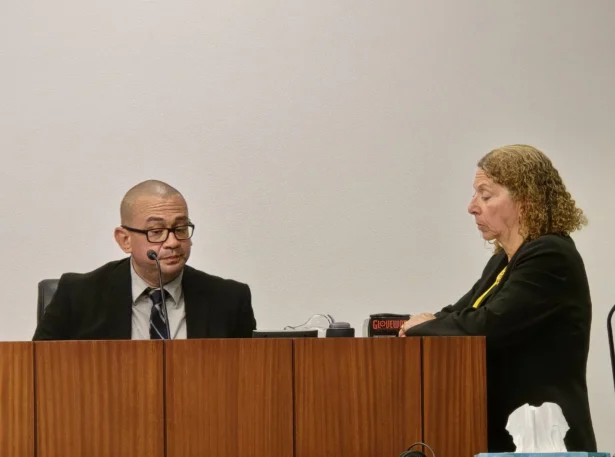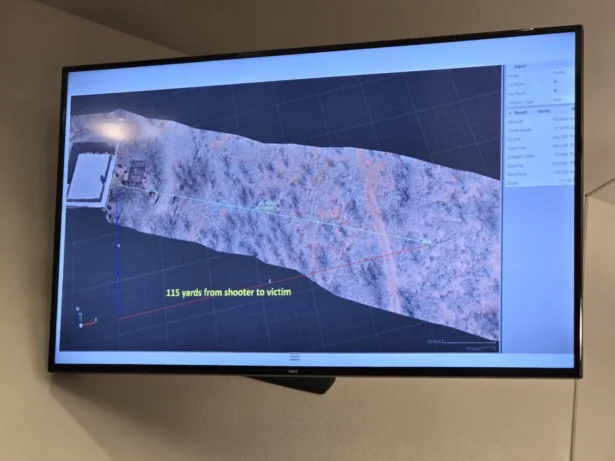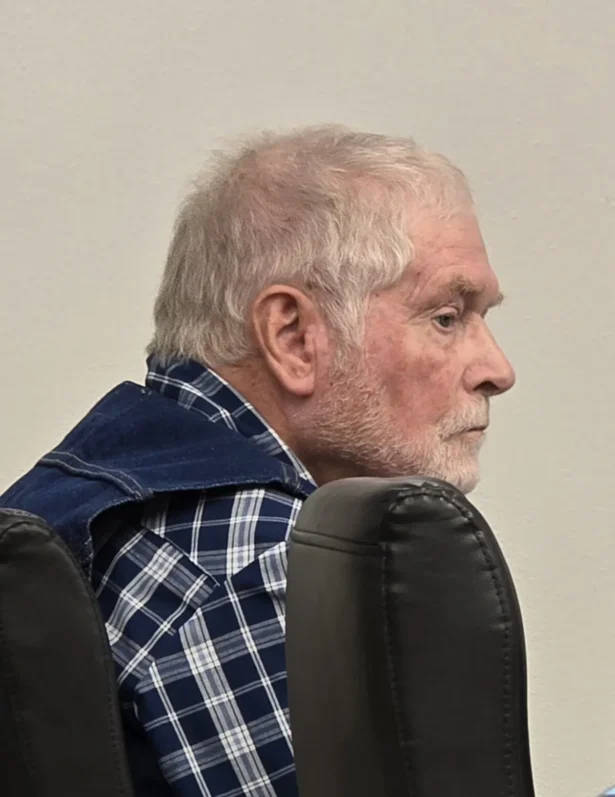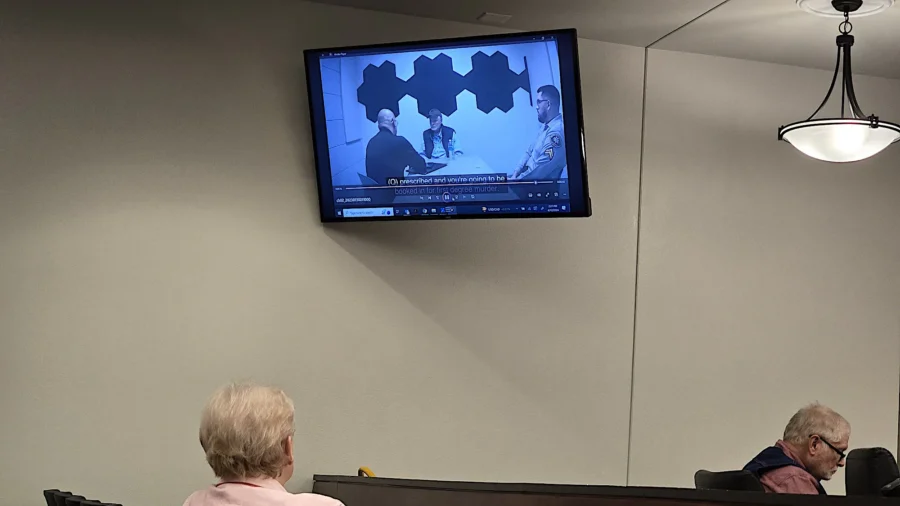NOGALES, Ariz.—On the night of his arrest, George Alan Kelly told investigators that he had “no reason to believe” that he shot and killed an illegal immigrant who was later found dead on his ranch property on Jan. 30, 2023.
“I’ve never been confronted with a situation such as this. I’m still somewhat agitated. I’m still quite nervous—upset,” Mr. Kelly said during the videotaped interview with detectives for the Santa Cruz County Sheriff’s Office.
Thirty minutes into the interview however, Mr. Kelly admitted to firing an AK-47 rifle over the heads of five illegal immigrants in tactical clothing he believed to be armed and trafficking drugs across his property.
“The moral of the story is you shot. Someone’s dead,” Detective Jorge Ainza, the lead investigator, told Mr. Kelly before his arrest.
On April 12, Mr. Ainza testified it was the defendant’s “inconsistent” statements, demeanor, and behavior that amounted to probable cause to charge him with first-degree murder.
Prosecutors later downgraded the charge to second-degree murder, which requires proof that Mr. Kelly acted in a reckless manner that caused the victim’s death.
Mr. Kelly, 75, a Nogales resident, is also accused of aggravated assault in the shooting death of Mexican citizen Gabriel Cuen-Buitimea, 48, who had entered the country illegally on Jan. 30, 2023.
During the 13th day of the trial, the prosecution played the jury a compact disc copy of the 50-minute video interview of Mr. Kelly in Santa Cruz County Superior Court in which the defendant vehemently denied any involvement in the victim’s death.
“I’m upset to the point you’d be if you found what I found,” Mr. Kelly told detectives Mr. Ainza and Mario Barba during the interview.
“Do you know why you’re here?” Mr. Ainza asked.
“Yeah, I know why they brought me down here—because I found a body on my ranch.”
The detective read Mr. Kelly his Miranda rights but he continued the interview without an attorney present.
Mr. Ainza then asked the suspect for a full account of the day, up until the time of the interview.
Mr. Kelly told detectives that while he was eating lunch around 2:30 p.m., he heard a gunshot—”close, close”—outside the house.
Through a window, he then saw his horse galloping across the pasture and a group of men in tactical clothing moving south toward a ravine around 150 yards away.
“This was unusual because these guys had full tan shirts and pants with full brown, big, solid backpacks,” Mr. Kelly said. “I saw them, and I heard the shot. And I went out there and saw them running down to” the ravine.
Mr. Kelly told the detective that he assumed the men were “drug runners,” and called the Border Patrol liaison on his cellphone and relayed the information.

During the interview, Mr. Kelly told the detectives he began walking after the men, a 40-caliber handgun holstered at his side and an AK-47 strapped around his shoulder.
The seven Border Patrol agents and sheriff’s deputies who responded to the first call for service were unable to locate the group of men after conducting a “cursory search” of the 170-acre ranch property, according to earlier witness testimony.
Mr. Kelly told investigators he later went to check on his horse when his two labradors alerted him to an unknown object in the nearby grass.
“I knew they had seen something—spotted something; smelled something. I walked over there and saw the body. It was lying face down,” the defendant told the detectives during the interview.
An autopsy conducted by the county medical examiner found that the victim died from an apparent perforating wound made by a gunshot from a distance. The bullet apparently entered through the victim’s right side and exited from the chest.
Investigators recovered nine spent shell casings from the ranch house porch that ballistics experts testified likely came from an AK-47.
However, the defense argued that the prosecution has yet to provide evidence that the fatal wound came from a bullet fired from the defendant’s rifle from a distance of 116 yards. Nor have investigators been able to locate the bullet.
“I knew this was bad,” Mr. Kelly told the two detectives during the interview. “I could tell the individual—I have medical training—wasn’t breathing. I knew—OK, I’ve got a body here; there is going to be an investigation. They’re going to need the evidence not to be contaminated. I backed up and went back to the house the way I came.”
Mr. Kelly said he made a second call to the Border Patrol, and a sheriff’s office dispatch called him a short time later.
The prosecution played that seven-minute conservation to the jury on April 12.

“You’re going to have to send an officer out here,” Mr. Kelly told the dispatcher.
“What’s going on?” she asked.
“I can’t—it’s very serious, ma’am. I’m not going to talk over the telephone,” Mr. Kelly answered.
When the dispatcher said the message from Border Patrol was that Mr. Kelly had “shot at something,” he immediately denied making the statement.
“I didn’t shoot at any—I haven’t shot at anything,” he said.
At another point during the call, Mr. Kelly stated, “OK, you know they say you have the right to remain silent; anything you say can and will be held against you? I’m not admitting to anything I’ve done, but all those things tend to add up.
“I don’t know what happened. I just know what I just saw about 15 minutes ago. And it’s something an ambulance cannot help. EMTs cannot help.”
“I didn’t say it was anybody. I just said it was a body.”
“I understand,” the dispatcher continued. “You’re trying to be careful. But I hope you understand I have to take care of my deputies, too.”
Mr. Kelly responded that he “only approached the body to make sure the animal—it’s not a vegetable or a mineral—wasn’t alive. And it was not alive. There is no sign of blood. There was just an animal laying face down.”

“An animal?”
“An animal—and you know what an animal is. It’s not a vegetable or a mineral. It’s a body. You know what I’m talking about.”
During the interview with detectives, Mr. Kelly vehemently denied shooting toward the group of men.
In the booking report, however, investigators wrote that the defendant “admitted to shooting at male subjects.”
As the interrogation continued, Mr. Ainza appears to become more confrontation with the suspect.
“I’m going to tell you this, George. I’m going to do a search warrant on your house,” he said.
“That’s fine,” Mr. Kelly responded.
“Whether you tell me or not, I’m going to find out. Let me tell you this: You know we conduct ballistics, correct?”
“Yes.”
“So, at some point, did you ever run after these people?”
“Run after them? No,” Mr. Kelly answered.
“At any time you saw these people running, did you feel your life was in danger?”
“Yes. Because I heard a shot fired,” Mr. Kelly replied.
The detective later told Mr. Kelly his statements weren’t “adding up.”
“You made some statements to deputies that are very concerning to me right now,” he said. “I’m going to give you the opportunity to be straight up with me—be honest. OK? This is your time to try to help yourself. Whether you shot this person by mistake or fear, you gotta let me know. Because I’m gonna do a search warrant on your house.”
“I understand,” Mr. Kelly responded.
“I’m going to do ballistics, and I’m going to recover the casing or the bullet and the body, and if it comes back to your weapon, you’re going to be in trouble.”
“I understand.”
“I’m giving you the opportunity right now to be real honest about this. If you shot [the victim], you have to let me know. You’ve got to be honest with me, George. Nothing is adding up right now. The statements you made on scene and what you’re telling me right now—”
“—I don’t know what didn’t add up,” Mr. Kelly replied.
“It’s not adding up.”
“Tell me what didn’t add up,” Mr. Kelly said.
“It’s the story, your demeanor, and your behavior. I’m going to ask you one more time—and be honest with me,” Mr. Ainza said.
“I’ve been honest with you.”
Mr. Kelly did not respond when the detective asked him directly, “Did you shoot? You made a statement to the station [you] shot something. OK?”

“To the Border Patrol agent? I didn’t make that statement. The agent said it. I didn’t say it. I didn’t make the statement that I shot at or shot somebody.”
“Did you shoot this gentleman [the victim]?”
“No!” Mr. Kelly shouted. “As far as I know. How can I know that?”
“You’re the one with the rifle. You’re the one that found the body hours after you spotted him. If that round came out of your AK-47 or AR-15, guess what?”
“I go to jail,” Mr. Kelly said.
‘Make This Right’
The detective pressed the suspect further.
“George. Look at me. I can see it in your eyes right now that you want to tell me something,” Mr. Ainza said. “I can see you want to make this right and be at peace with yourself. If you shot this gentleman, you gotta let me know now. If you keep lying, it’s going to get worse for you. Did you shoot?”
Mr. Kelly hesitated. “Not—”
“George. Did you shoot at this gentleman?”
Speaking in a low voice, Mr. Kelly responded, “I did not shoot at this gentleman.”
“Did you shoot?”
“Yes. I shot over their heads.”
“OK. Well. You struck something. And that person is dead right now,” the detective said.
“I don’t know.”
During questioning of the witness, Defense attorney Kathy Lowthorp said authorities continued using the narrative that Mr. Kelly shot directly at the group of men despite his repeated denials.

He also told investigators that one of them turned and pointed a rifle toward the defendant while running parallel to him.
“What part of raising his rifle to the subject that pointed a rifle at him is illegal?” Ms. Lowthorp asked the witness.
“Ma’am. You’re meaning of shooting at them—shooting over their heads—it’s different from my vantage. Doing that is reckless. It’s dangerous,” Mr. Ainza responded.
The attorney then asked the witness how the defendant could have shot at the group of men as they were heading south when the victim’s body lay due east.
“How does that gun pointed at the people to the right affect the person that’s due east? How does that happen?” Ms. Lowthorp asked. “How’s that reckless? And how did it happen?”
“The evidence shows, ma’am, that Mr. Kelly came out on his porch and shot towards the direction. The body is dead directly behind his porch,” Mr. Ainza replied.
“That’s your testimony, sir. What evidence do you have of that?”
“The trajectory of the bullet, ma’am, coming in and out of the body is coming from the direction of the Kelly house. It goes from right to left, from bottom into the chest,” the witness replied.
“The problem is, sir, that the burden of proof and probable cause, now in the court [to be proven] beyond a reasonable doubt, lies with you guys. What evidence do you really have, sir?” Ms. Lowthorp asked the detective. “Everyone searched out there, and no one found a body. We don’t even know if that body walked later or was there—we just don’t know. We don’t have that evidence? True?”
‘Right to Self-Defense’
“That’s correct,” the witness replied.
The detective later testified that Mr. Kelly’s “unlawful discharge of a firearm” amounted to a “disregard for human life.”
“He went out there and shot a man,” Mr. Ainza added.
Ms. Lowthorp then asked, “You do believe in the ability of self-defense and that all Americans have a right to defend themselves. Correct?”
“I do believe that, ma’am.”
The attorney then made a motion with her hand as if she were pointing a gun at the witness.
“What would you do if I [shot]? Be honest. What would you do?”
“I would shoot back,” Mr. Ainza replied.
“Sir, do you need to wait until a bullet hits you before you return fire?” Ms. Lowthorp said.
“I’m not saying that, ma’am.”
Ms. Lowthorp followed with an opinion.
“Personally, I wouldn’t have done what he would have done. I would have shot at the person with the rifle and not shot up in the air,” she said.
From The Epoch Times

